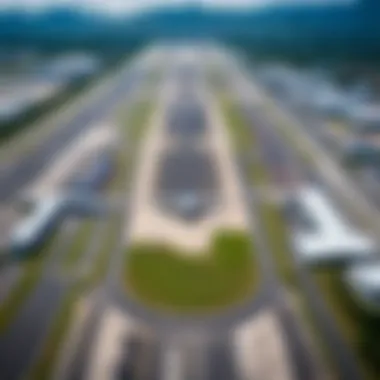Exploring Phuket's Airports: Travel Insights & History


Intro
Phuket, Thailand, is known for its stunning beaches and vibrant nightlife. Yet, less visible but equally important is its network of airports that support the travel industry. Understanding these airports is essential for both seasoned tourists and newcomers looking to experience all that Phuket offers.
The main airport is Phuket International Airport, which serves both domestic and international flights. This airport is a crucial gateway for millions of travelers each year. It connects the island to various global destinations, enhancing its attractiveness as a tourist hotspot.
Travelers should know about the airport’s history regarding development and expansion. The timeline of Phuket International Airport reflects growth in the region and the need for stronger travel infrastructure.
The airport's facilities cater to various needs, from dining to shopping. Understanding what is available can enhance the travel experience and streamline the journey.
Insights regarding passenger services are also valuable. Efficient services can significantly reduce stress during travel. Knowing about check-in procedures and security protocols will aid in a smoother travel experience. This knowledge is especially useful for first-time visitors who may feel overwhelmed.
Moreover, the significance of effective transportation cannot be overlooked. The efficient operation of airports plays a pivotal role in ensuring a positive travel experience. This article will delve deeper into all aspects of Phuket’s airports, establishing key insights for every traveler.
Overview of Phuket Airports
Understanding the airports of Phuket provides key insights into travel dynamics in Thailand's popular tourist destination. Phuket's air travel scene consists primarily of Phuket International Airport, a critical hub that facilitates access to the island. Its operational capacity significantly impacts tourism, connecting travelers from around the globe. The success of air travel in this region is not only defined by the number of flights but also by services, infrastructure, and connectivity to other transport means.
Preface to Phuket's Air Travel
Phuket's air travel network is a crucial component of its tourism infrastructure. As the main gateway, Phuket International Airport supports millions of passengers annually. The airport connects Phuket to major cities in Asia, Europe, and beyond, promoting economic logistics and tourism. Domestic flights within Thailand also play a significant role in the overall transportation framework, linking rural areas with the bustling tourist economy.
In recent years, the increase in budget airlines has made air travel more accessible. Lower fares have attracted more visitors, driving growth and demand. Efforts to enhance facilities and efficiency at Phuket's airports reflect this trend.
Importance of Air Connectivity
Air connectivity in Phuket is essential for sustaining the tourism industry. The island relies heavily on travelers arriving by air for economic growth. Flights connect Phuket to destinations that range from Bangkok to various international locations. This connectivity fosters international relations and promotes cultural exchange.
Moreover, effective air transport networks can enhance visitor satisfaction and encourage repeat travelers. An interconnected and coordinated approach to airport operations facilitates smooth transfers for passengers. Moreover, future plans for development will focus on improving air connectivity to further increase the economic benefits of tourism.
"Air travel in Phuket serves beyond transportation. It is a gateway to culture, experiences, and commerce."
The ongoing development of Phuket's airports will cater to the increasing passenger demand as well as align with global aviation trends. Balancing efficiency and passenger services will determine the future trajectory of air travel in Phuket.
Understanding the airports in Phuket is fundamental for exploring comprehensive travel options and preparing for an enriching experience in Thailand.
Phuket International Airport: A Closer Look
Phuket International Airport serves as a pivotal hub not only for the transport of passengers but also for the economic growth of Phuket and surrounding regions. It facilitates a large volume of both international and domestic flights, thus reinforcing Phuket's position as a top tourist destination in Southeast Asia. Understanding the airport's operations, facilities, and historical context brings clarity to its integral role in air travel and tourism in Thailand.
History and Development
Phuket International Airport began operations in 1976. The airport has undergone significant transformations to accommodate the increasing number of travelers. Initially a small facility, it was not well-equipped to handle the boom in tourism that Phuket experienced in the late 1980s and 1990s. Recognizing this need, the Thai government invested heavily in expansions and upgrades, which include terminal enhancements and improved runways.
Over the years, the airport's capacity has expanded dramatically. The introduction of an international terminal in the early 2000s highlights a ceaseless commitment to improving services. Given that the airport is a vital entry point for nearly 10 million people each year, ongoing developments ensure safety and comfort for air travel.
Terminal Facilities and Services


Phuket International Airport features two main terminals: one for domestic flights and another for international travelers. This division is crucial for streamlining operations and managing passenger flow. The terminals are equipped with modern amenities designed to enhance traveler comfort and convenience.
Facilities include:
- Diverse Dining Options: Ranging from fast food to local Thai cuisine, the options cater to various palates.
- Shopping Outlets: Duty-free shops offer a variety of products, from cosmetics to souvenirs.
- Lounge Areas: For travelers seeking comfort, lounges provide a relaxing environment to unwind before flights.
- Wi-Fi Access: Complimentary Wi-Fi facilitates connectivity for those needing to work or stay in touch during their travels.
These amenities reflect a commitment to providing a positive airport experience, essential for keeping Phuket competitive in the tourism sector.
Airlines and Destinations
Phuket International Airport is a central node for numerous airlines offering both international and domestic services. Major carriers such as Thai Airways, AirAsia, and Emirates operate from this airport, connecting Thailand to various global locations.
Common destinations include:
- Domestic Routes: Bangkok, Chiang Mai, and Pattaya.
- International Destinations: Cities like Singapore, Beijing, and Dubai are frequented by travelers.
The diversity of airlines and destinations supports not just tourism but also business travel, further contributing to Phuket’s economic landscape.
This section illustrates how Phuket International Airport stands as a cornerstone of connectivity in the region, benefiting both tourism and local economic growth.
The Role of Domestic Airports
Domestic airports play a crucial role in connecting Phuket with the broader landscape of Thailand. They serve as vital links for both residents and tourists, offering increased accessibility to the island and facilitating regional travel. The benefits of these airports extend beyond mere transportation; they also support economic growth, tourism, and cultural exchange.
Domestic aviation in Thailand encompasses a network of airports that enables seamless travel between various regions. This connectivity is essential for fostering tourism, with Phuket often seen as a prime destination for both international visitors and local travelers.
Understanding Domestic Aviation in Thailand
Domestic aviation in Thailand is characterized by a well-structured system of airlines and airports. Major airlines such as Thai Airways and Bangkok Airways operate frequent flights to and from Phuket, catering to a high demand for travel. The domestic market is robust, with low-cost carriers also making air travel more accessible for the average Thai citizen.
Airports like Krabi Airport and Surat Thani Airport facilitate travel to Phuket, serving as entry points for those arriving from other parts of the country. The ease of accessing these airports has significantly enriched the travel experience, allowing visitors to explore the diverse attractions of Thailand.
Popular Domestic Routes to Phuket
Phuket is connected to many significant cities within Thailand through a variety of popular domestic routes. Some of the most frequented connections include:
- Bangkok to Phuket: This route is the busiest, connecting the capital city with the island multiple times a day.
- Chiang Mai to Phuket: An attractive route for those seeking to travel between the north and south of Thailand.
- Koh Samui to Phuket: Provides an easy link between these two popular island destinations.
- Krabi to Phuket: Often used by travelers exploring both islands and enjoying the beautiful Andaman coast.
As domestic travel continues to grow in popularity, these routes not only provide convenience but also enhance the overall travel infrastructure around Phuket, fostering a thriving tourism industry.
"Effective domestic connectivity significantly influences Phuket's appeal as a travel destination, increasing the flow of tourists and enhancing local commerce."
Transport Links to and from Airports
Transport links to and from airports are crucial for ensuring a seamless travel experience. For travelers arriving in Phuket, effective transport connections can enhance convenience and reduce travel stress. This section will explore the various options available, emphasizing the benefits they offer to both tourists and locals. Understanding these links is essential, especially given Phuket's popularity as a tourist destination and its vibrant economy that relies heavily on tourism.
Ground Transportation Options
Upon arrival at Phuket International Airport, passengers will discover multiple ground transportation options. Buses, taxis, and shuttle services are key modes of transport that cater to diverse needs. The availability of these services allows travelers to choose between affordability and convenience.


- Airport Shuttle Buses: These are a cost-effective solution for getting from the airport to popular destinations. They typically run on fixed routes to major hotels and tourist areas.
- Taxis: Taxis are readily available and provide a direct ride to desired locations. However, it is recommended to negotiate the fare beforehand, as some drivers may not use meters.
- Private Transfers: For those seeking a more personalized experience, private transfer services can be pre-booked, assuring comfort and safety during transit.
Airport transport is integral in establishing Phuket as a welcoming destination. Therefore, the presence of multiple options enriches the travel experience and contributes to overall satisfaction.
Car Rentals and Shared Services
Car rental services are another vital element of Phuket's transport links. They offer travelers greater flexibility and independence during their stay. Major car rental companies operate at the airport, providing a variety of vehicles to suit different preferences.
- Major Car Rental Agencies: Companies like Avis, Hertz, and Budget have counters at the airport, making it easy to rent a car immediately upon arrival.
- Requirements: Travelers need to present a valid international driving license and a credit card. It is advisable to check specific terms and conditions before renting.
Shared services, such as ride-sharing applications, have also gained popularity. Services like Grab, similar to Uber, allow passengers to book rides easily via an app. This offers a cashless experience and provides estimated fares ahead of time.
Overall, the transport options available at Phuket International Airport cater to a wide range of traveler preferences. By understanding these linkages, visitors can make informed decisions that enhance their journeys through this beautiful island.
Airport Operations and Management
Airport operations and management are vital components of the air travel ecosystem, especially in a tourism-driven location like Phuket. Efficient management ensures smooth functioning of all airport activities—ranging from passenger handling to air traffic control. Various factors contribute to operational success, such as logistics, staff coordination, and regulatory compliance. The significance of these elements cannot be overstated, as they ultimately affect the travel experience.
Operational Challenges
Phuket's airports face several operational challenges that can affect efficiency and passenger convenience. These issues include:
- Capacity Constraints: As tourist numbers increase, airports may experience congestion at peak times. Limited space for both passengers and planes can lead to delays and discomfort.
- Weather Conditions: Phuket is subject to tropical weather, including heavy rains and storms. Such conditions can cause flight delays and cancellations, complicating operations.
- Security Standards: Enhanced security measures are essential but can also result in longer wait times and operational bottlenecks. Finding the balance is a continuous challenge.
Addressing these challenges requires innovative solutions, including improved scheduling and better resource allocation. The management teams constantly analyze performance metrics to implement necessary changes.
Sustainability Initiatives
In an age where environmental concerns are paramount, Phuket's airports are taking steps towards sustainability. Initiatives include:
- Energy Efficiency: Adoption of energy-saving practices, such as LED lighting throughout the terminals, reduces electricity consumption.
- Waste Management: Programs aimed at reducing, recycling, and composting waste generated by travelers help minimize environmental impact.
- Community Engagement: Local communities are involved in sustainability efforts, promoting responsible tourism and conservation initiatives.
Efforts are directed towards ensuring that the airport operations align with broader environmental goals, aligning with international standards on ecological responsibility.
By addressing these operational challenges while embracing sustainability, Phuket's airports not only enhance the passenger experience but also contribute to a more responsible tourism framework.
Passenger Experiences at Phuket Airports
The passenger experience is vital in assessing the operational success of airports, particularly in a travel-centric hub like Phuket. The way travelers interact with the airport affects their overall journey. In this section, we examine the critical components of the passenger experience at Phuket's airports. The focus lies on waiting and boarding areas as well as food and beverage options, both crucial elements that directly influence traveler satisfaction.
Waiting and Boarding Areas
Waiting and boarding areas in Phuket airports are designed to provide comfort and convenience. These spaces allow passengers to relax before their flights. Seats are ample and often arranged for easy access. Travelers can expect certain amenities such as charging stations for electronic devices and free Wi-Fi services.
The layout of these areas is crucial for flow and efficiency. Clear signage helps passengers navigate the airport and locate their gates without frustration. It's important that these areas also cater to families and those with special needs, ensuring inclusivity.
Moreover, the atmosphere in the waiting areas greatly impacts the travel experience. Natural light and thoughtful decor make these spaces more pleasant. In addition, some areas may have local art displays, linking the airport to Phuket's rich cultural heritage. Overall, the design and functionality of waiting and boarding areas reflect the commitment to passenger comfort and satisfaction.


"A seamless transition from check-in to boarding significantly uplifts the traveler's experience and can set the tone for their trip."
Food and Beverage Options
Travelers at Phuket airports can expect a diverse range of food and beverage options. These are essential as they provide nourishment and refreshment during long waits. From local Thai cuisine to international fast food chains, there is something for everyone.
Restaurants and cafés cater to various tastes and dietary preferences. For instance, vegan options are increasingly common, reflecting a global dietary trend. Many establishments also offer Thai dishes, enabling travelers to enjoy local flavors even before they reach their destination.
Additionally, it’s important to note the pricing structure. Some outlets offer affordable meals, while others may be more premium, reflecting various budgets effectively. Clear menus and visible pricing make it easier for passengers to make informed decisions.
Security Measures and Regulations
Security is a paramount concern in the aviation sector. This is especially true for Phuket airports, given the influx of international travelers each year. These security measures are not just about compliance, but they also play a crucial role in ensuring the safety of passengers, staff, and the aircraft. The focus on strict protocols and efficient management can enhance the overall travel experience.
Enhanced Security Protocols
Phuket’s airports have implemented enhanced security protocols to address the diverse threats in today's aviation environment. Measures include advanced screening technologies at checkpoints and increased personnel training.
- Advanced Screening Technologies: These technologies include full-body scanners that can detect a variety of concealed items without physical contact. They help speed up the screening process while maintaining a high level of safety.
- K9 Units: Trained dogs are introduced at various points within the airport. They are effective in detecting narcotics, explosives, and even aggressive behaviors.
- Regular Security Audits: Regular evaluations of security measures ensure that they meet international standards and adapt to emerging challenges. This commitment to consistent review enhances confidence among travelers.
By focusing on these elements, Phuket airports aim to mitigate risks effectively while providing a smoother transit experience.
Passenger Safety Guidelines
In addition to robust security measures, passengers are encouraged to follow certain guidelines to ensure their safety and that of fellow travelers. Adhering to these guidelines contributes significantly to the overall safety culture at the airports.
- ID and Documentation: Always carry valid identification and travel documents. These are essential for passing through security checks.
- Arrive Early: Giving yourself ample time before your flight reduces stress and allows for unexpected delays in security checks.
- Follow Instructions: Pay close attention to the instructions given by security personnel. They are trained to ensure a safe environment.
- Report Suspicious Activity: If you notice anything that seems unusual, report it immediately to airport staff. Vigilance is key in maintaining security.
"Safety is not just the responsibility of airport authorities. It requires cooperation from all passengers."
By fostering an environment of safety and responsibility, Phuket airports strive to provide travelers with peace of mind. Overall, understanding these security measures and regulations can enhance the travel experience for both new and experienced tourists.
Future Developments in Phuket Airports
The future of Phuket's airports is crucial for maintaining the region's status as a premier tourist destination. As travel demand continues to grow, it is necessary to invest in infrastructure and technology to improve the efficiency and capacity of the airports. Proper planning can enhance passenger experience, ensure sustainability, and facilitate economic growth.
Expansion Plans
The expansion plans for Phuket International Airport signify a strategic move to accommodate rising traveler numbers. Currently, the airport handles millions of passengers each year, which often leads to congestion during peak travel times. Future developments include the addition of new terminals and increased runway length. This expansion aims to streamline operations and reduce waiting times.
Moreover, the addition of new boarding gates and upgraded customs facilities will significantly enhance the flow of passengers.
"The growth in passenger traffic necessitates a focused approach to expansion and efficiency in operations."
Not only will these expansions improve the passenger experience, but they will also attract more international airlines. This, in turn, will lead to increased competition and potentially lower fares for travelers. Local businesses can also benefit from the tourism influx generated by enhanced air connectivity.
Technological Advancements
Technological advancements play a pivotal role in the future developments of Phuket's airports. The integration of advanced systems can lead to a smoother passenger experience from check-in to boarding. Innovations like biometric screening and automated check-in kiosks can reduce waiting times and increase efficiency.
Additionally, investing in smart technologies such as real-time flight information systems and mobile applications can enhance communication with passengers. These systems help in providing timely updates about delays or gate changes.
Furthermore, airports need to consider environmental technologies. Sustainable practices, such as solar energy utilization and waste management systems, have become increasingly important. These measures not only reduce the carbon footprint but also resonate with eco-conscious travelers.
As Phuket airports look forward toward future developments, a balanced approach between expansion and technological upgrades will be key to ensuring they meet the demands of modern travel. Enhancing infrastructure, adopting new technologies, and focusing on sustainability will consolidate Phuket's position in the aviation sector.







